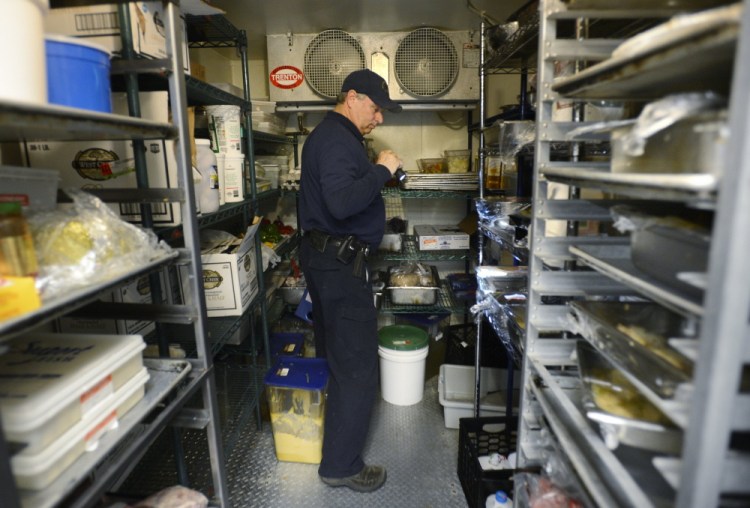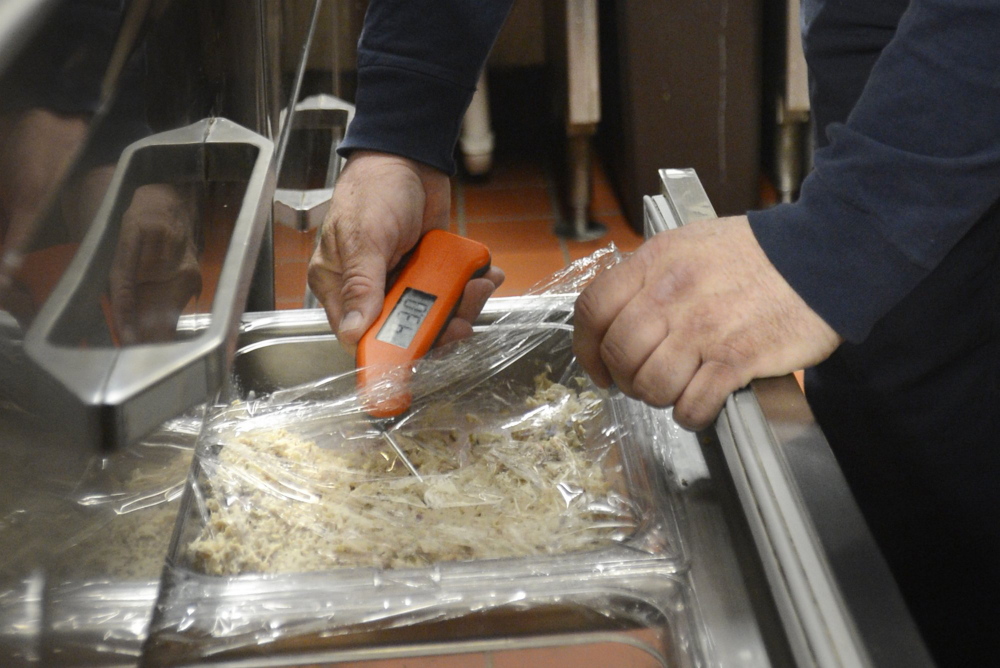Restaurant patrons across the state may soon be able to look up an establishment’s health inspection reports before going out to dinner, the result of a new database being purchased by the state Center for Disease Control and Prevention.
Once the information is posted, Maine would join the vast majority of states that already provide some online access to inspection records.
The move to open access to inspection reports comes as a Yarmouth lawmaker is pushing to expand the team of state health inspectors so they can get to each restaurant more frequently to check kitchens and look for improperly stored foods. A legislative committee is scheduled to hold a public hearing Monday morning on the bill.
Nancy Beardsley, the director of CDC’s Division of Environmental Health that oversees the Health Inspection Program, said replacing the state’s database has been a goal since 2007, but a 2013 investigation by the Maine Sunday Telegram added urgency for the state to act.
“The paper’s work was really important to emphasize and bring to light the issues with our lack of technology,” Beardsley said last week. “I do think in the wake of that press we did have a renewed focus and I would say that was maybe the catalyst to renew that effort to find a replacement.”
The Telegram investigation found that lawmakers reduced the frequency of restaurant inspections in 2011, at the same time consumer complaints were increasing. Lawmakers did not know about the trend in complaints because of the lack of state data at the time that made it difficult to discern trends and inform training and education efforts.
The paper also found that there was a lack of staff to keep up with inspections and that failure rates varied greatly among the state’s 11 public health districts. For example, only one out of 334 inspections in Washington County from 2010 to 2012 failed. That’s a failure rate of 0.3 percent. But in Sagadahoc County, 25 out of 193 inspections failed. That’s a 13 percent failure rate – the highest in the state.
Also, Maine was one of the few states not to offer any sort of state, county or local inspection records online, the paper found. The Telegram began posting some inspections online in the spring of 2013, and the city of Portland followed suit that summer.
“The public has been asking for that and we want to be able to provide that,” Beardsley said.
The new system may also make the inspections regimen more efficient, improving the state’s ability to follow up more often with restaurants that have a history of violations. It will also allow them to compare failure rates from one county to another to ensure that inspections are consistent statewide.
The contract is still being finalized, Beardsley said, so details about its cost could not be released. “We are very close to completing a contract. It will be public very soon,” she said.
The inspection reports are expected to be online next spring.
DATABASE USED ELSEWHERE
Department spokesman John Martins said the database is used by several other states, including Arkansas, Iowa, Minnesota, Pennsylvania, South Dakota and, more recently, Vermont. How the states provide the information online can vary.
Iowa’s database, for example, allows people to search inspection records within a certain time frame by city, by restaurant name or by address. Users can see the number of violations and get a brief summary of each violation. However, it is not clear on the site whether the restaurant passed or failed its inspection. While the site appears to have the ability to post full inspection reports, that function was not working last week.
Pennsylvania’s interface is similar to Iowa’s, but users can see whether the establishment is in compliance with the food code.
South Dakota takes it a step further, showing the number of critical and noncritical violations, as well as the overall score. Critical violations, such as storing food at the wrong temperature, can immediately affect food safety, while noncritical violations, such as a bathroom door not fully closing, do not. But neither the full inspection report nor a description of the violations is available.
Greg Dugal, the president and chief executive officer of the Maine Restaurant Association, said the group understands the state’s move to post reports online, since there is public interest in the issue. However, he hopes the database will include information about which violations are important for food safety and which are not, as well as let people know an inspection is a snapshot in time.
“I wouldn’t say we’re excited about it, but we certainly understand why they’re doing it,” Dugal said. “It’s hard for them to keep up with all of the public’s requests.”
RECENT STATE FAILURE RATES
A restaurant can pass an inspection with as many as three critical violations and 10 noncritical violations. A restaurant can exceed those thresholds and still remain open if it immediately corrects enough of the problems. If it cannot fix enough problems on the spot, the restaurant is deemed an imminent health hazard and is asked to close until the violations are addressed.
From 2010 to 2012, restaurants inspected by the state failed at a rate of 6.3 percent.
In 2013, 4.6 percent of the 3,417 restaurants inspected failed, with three being deemed imminent health hazards.
The failure rate was 4.1 percent in 2014, when 3,602 establishments were inspected and 11 of them deemed to be imminent hazards.
So far this year, 5.9 percent of the 476 restaurants inspected have failed their inspections, according to a Maine Sunday Telegram analysis of state data. Three restaurants have been deemed imminent hazards and have had to close until the issues were resolved.
Meanwhile, consumer complaints have increased dramatically since the 2013 Telegram report drew attention to the state’s struggle to keep up with inspections. Complaints can range from reports of apparently unsanitary practices in the kitchen to suspected foodborne illnesses, although those are rarely proved.
Lisa Roy, manager of the Health Inspection Program, said the department received 420 complaints in 2013, which was nearly double the 215 complaints filed in 2012.
In 2014, the department received 376 complaints and so far this year 69 complaints have been filed, Roy said.
MORE INSPECTORS SOUGHT
While the state is rolling out a new database, the Legislature’s Health and Human Services Committee is slated to hold a public hearing Monday morning on a bill to increase the number of health inspectors.
The goal is to conduct annual, rather than biennial, inspections. The bill does not say exactly how many new inspectors would be needed to reach each restaurant once a year and it does not include any information about the potential cost. Those details will have to be spelled out before any approval by the Legislature.
Currently, there are 11 state inspectors who are each responsible for inspecting 600-800 establishments, including restaurants, hotels, summer camps and tattoo parlors. There are more than 8,000 licensed food service entities in the state.
Unable to meet a previous state requirement to inspect establishments annually, the Legislature in 2011 voted to reduce the frequency of inspections to over two years, while requiring each restaurant to have a certified food protection manager. Unknown to lawmakers at the time, the change was made when complaints from customers had increased 87 percent from 2008 to 2012, when the law took effect.
Rep. Janice Cooper, D-Yarmouth, who is sponsoring L.D. 715, noted Portland’s efforts to beef up its inspection program and believes the state should do the same.
Portland is one of only five communities that have been delegated inspection authority over its restaurants.
The city hired its first health inspector in 2011. After a series of high-profile restaurant closures, the city increased its staffing to 2.5 inspectors, began posting inspections online and started offering more food safety courses for restaurant employees.
Portland restaurant owners and city officials told the Telegram last week that the changes have led to cleaner kitchens and more knowledgeable kitchen staffs.
“Portland has really picked up the pace,” Cooper said. “Most of the state is still subject to state inspections so who knows what’s going on out there.”
Dugal, of the restaurant association, said the group opposes Cooper’s bill, because the health inspection program is funded by fees paid by restaurant owners. Any large increases in license or inspection fees could put restaurants, which traditionally have thin profit margins, out of business, he said.
“That could be catastrophic for us,” said Dugal, who could support hiring more inspectors if the costs were funded through the state’s General Fund.
Cooper said she submitted the bill after the Legislature last year killed a bill to beef up inspections by allowing local health officers to conduct limited inspections of restaurants. That bill faced opposition because local health officers are not certified to enforce the Maine Food Code and that could lead to inconsistent inspections and confusion among restaurant owners, opponents said.
Although that bill was struck down, the state agreed to examine the role the local officers could play in restaurant inspections.
Cooper and members of the Health and Human Services Committee expected a follow-up report about how many inspectors would be needed to conduct annual inspections, but she said that never happened. Cooper said she was pleased to learn about the new database, but she’s still committed to getting more inspectors.
“That’s progress, but it’s not boots on the ground,” she said.
Send questions/comments to the editors.






Comments are no longer available on this story